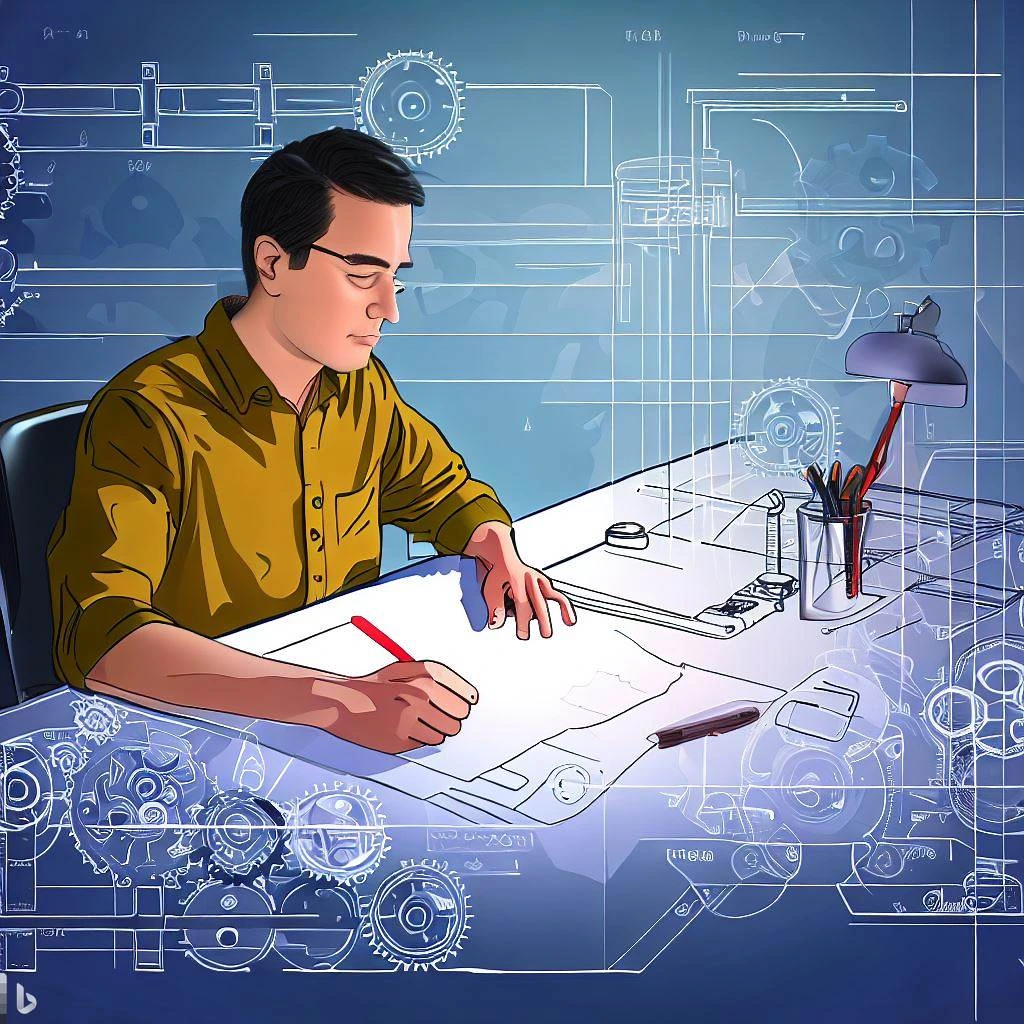Understanding Different Views and Projections for SolidWorks Drawing Assignments


The mechanical engineering, product design, and manufacturing sectors all rely heavily on SolidWorks, a flexible and widely used computer-aided design (CAD) program. Learning how to create precise, thorough engineering drawings is one of the keys to using SolidWorks effectively. These drawings act as a crucial tool for communication, allowing engineers, designers, and manufacturers to comprehend and precisely reproduce complex designs.
It's crucial to comprehend various views and projections thoroughly when working on SolidWorks drawing assignments. Views give engineers and designers a way to effectively communicate design intent, dimensions, and other specifications by representing a three-dimensional object in a two-dimensional format.
We will examine the world of SolidWorks drawing assignments in this blog, paying particular attention to understanding various views and projections. We will delve deeper into different view types, projection techniques, and the importance of each for producing precise and thorough SolidWorks drawings. By the time you finish reading this blog, you'll fully grasp how to use SolidWorks' various views and projections to produce engineering drawings of industry-standard quality.
An Introduction to SolidWorks Drawing:
Engineers and designers all over the world use SolidWorks assignment help, a powerful computer-aided design (CAD) and computer-aided engineering (CAE) program. SolidWorks' capacity to produce accurate and detailed 3D models and, more importantly, its capacity to translate these 3D models into 2D engineering drawings are some of the key features that make it an invaluable tool in the engineering domain. The ability of SolidWorks to represent complex three-dimensional objects in standardized two-dimensional drawings that can be easily understood and interpreted by engineers, manufacturers, and other stakeholders in the product development process is crucial for producing engineering drawings. By doing this, it gets rid of ambiguities and creates the framework for effective communication between the various parties involved in the project.
Different views and projections are used during the conversion of 3D models to 2D drawings. To represent a three-dimensional object in two dimensions in technical drawings, these are the typical techniques used. Any engineering student or professional who wants to master SolidWorks and utilize its drawing capabilities must fully comprehend these views and projections.
Orthographic Projection:
Orthographic projection is SolidWorks' initial and most popular view. Orthographic projection, which has its roots in descriptive geometry, involves displaying an object's various faces in a two-dimensional format. The front view, top view, and right-side view are all included in the conventional orthographic projection. Each view depicts a different side of the 3D object from that particular angle, maintaining the actual sizes and proportions. It is possible to understand the object's overall shape and size because these views are positioned in relation to one another based on its principal dimensions.
In SolidWorks, orthographic projection is a critical component of producing engineering drawings. Once you have a 3D model, you can use SolidWorks' 'Drawing' module to automatically produce the various orthographic views. Depending on the needs of the drawing, this module can generate additional views such as the bottom view, left-side view, rear view, etc. in addition to the standard orthographic views.
- Isometric View: The isometric view is the following frequently employed view in SolidWorks drawings. An example of an orthographic projection is the isometric view, in which the object is depicted from an angle that makes all three of its main axes visible in the drawing. This view, which is a pictorial representation rather than an actual projection, offers a 3D perspective of the object and makes it simple to comprehend its general configuration and shape. SolidWorks drawings use isometric views to communicate an object's visual appearance and establish a physical link between abstract 2D drawings and the real 3D object.
- First Angle Projection: First-Angle Projection and Third-Angle Projection are the two primary projection types used in engineering drawings. The projection technique to be used is determined by the convention followed in the specific area or sector. The object is conceptually placed in the first quadrant of the first-angle projection, between the observer and the projection plane. The plane then unfolds to reveal all the various views as the projection of the object slides behind it as a result. In SolidWorks, you can configure your drawing sheet's 'Properties' dialog box to use first-angle projection. In many European nations, this kind of projection is used frequently.
- Angle Projection: Contrarily, the object is positioned in the third quadrant, behind the projection plane, in the third-angle projection. As a result, the projections land in front of the plane, which is then unfolded to show the various perspectives. The default setting in SolidWorks is third-angle projection, which is mainly used in the US.
It's important to comprehend the distinction between first-angle and third-angle projection because it affects how your drawing's views are organized. While the left view is positioned on the right side of the front view in the first-angle projection and the top view is positioned below the front view in the third-angle projection, the left view is positioned on the left side of the front view in the first-angle projection.
Comprehensive Knowledge of SolidWorks Drawings:
While it's important to understand the fundamentals of views and projections, mastering SolidWorks drawings necessitates a deeper understanding of the various strategies and tools available in SolidWorks. Knowing how to use detail views to highlight particular areas of the model, section views to reveal the model's internal details, broken-out section views for partial section views, and crop views to remove superfluous model elements are all part of this skill.
Another important feature of SolidWorks drawings is the use of dimensions and annotations, which provide the crucial information required to produce the part or put the system together. This includes geometric dimensioning and tolerancing (GD&T), a methodical way to write the part's functional specifications right on the drawing.
SolidWorks also gives users the option to organize and present additional information pertaining to the part or assembly using tables, such as the bill of materials (BOM), revision tables, and design tables. Drawings can be made in a lot less time and with a lot less chance of error thanks to the ability to automatically generate these tables from model data.
Advanced SolidWorks Drawing Techniques:
SolidWorks provides more sophisticated features to support complex design representations in addition to the fundamental projections and views. Expansion views, alternative position views, and other sophisticated techniques are among them.
Exploded views are a helpful tool in SolidWorks when working with assemblies. An exploded view separates each component of an assembly from the others, typically along an axis that aids in understanding the sequence of assembly or disassembly. Understanding how various components of an assembly work together and contribute to the overall functionality of the design can be aided by this.
In SolidWorks, the assembly environment can be used to create an exploded view. After the exploded view has been defined, it can be inserted into the drawing environment and labeled with balloons. A corresponding bill of materials that lists the components, how many there are, and other necessary details can also be produced automatically.
Various Position Views
The range of motion of an assembly or a specific part within an assembly is displayed using alternate position views. When a part or assembly has multiple positions or configurations, this kind of view is very helpful. It might display a door hinge's open and closed positions, for instance, or a telescoping mechanism's extended and retracted positions.
In SolidWorks, you require an assembly with at least one part that has a degree of freedom in order to create an alternate position view. Then, within the drawing environment, you can produce a different position view that displays the moving part's various positions. Solid lines are used to depict the primary position, while phantom lines are used to depict the alternative positions.
Additional Views: Advancements in SolidWorks Drawing Projections:
Traditional orthographic projections might not be sufficient for intricate and non-orthogonal parts. For an effective representation of these complexities, SolidWorks provides cutting-edge projection techniques like auxiliary and detail views.
Features that are not parallel to any of the common orthographic planes are shown using auxiliary views. The inclined surface can be seen in its true size and shape when the object is projected onto a plane that is parallel to the inclined surface in an auxiliary view. For parts with significant features at arbitrary angles, this type of view is imperative.
By choosing a line in an existing view that is parallel to the direction of sight for the auxiliary view, auxiliary views in SolidWorks can be created in the drawing environment. An auxiliary view that is projected in the selected direction is then produced by the software.
Views in Detail:
Detail views are used to magnify and highlight a specific portion of the model that might be too small or intricate to be seen clearly in the regular views. This kind of perspective is especially useful when dealing with complex designs where it's important to highlight specific areas for proper manufacturing or assembly.
Drawing a profile around the area of interest in an existing view in SolidWorks makes it simple to create detail views. The chosen area is then displayed in an enlarged scale in a detailed view that is then generated.
A complete set of tools and methods are available in SolidWorks for producing engineering drawings. Understanding when and how to use these tools effectively, though, is where true mastery lies. The secret to effective engineering communication is understanding the various views and projections and knowing how to use them to represent your designs accurately and completely. It will be beneficial to you in your academic work as well as your professional engineering career. So jump in, put your skills to the test, explore, and, most importantly, have fun as you learn and create with SolidWorks.
Conclusion:
Mastering SolidWorks drawings is a lifelong process that calls for perseverance, practice, and an analytical frame of mind. You can create detailed, accurate, and thorough drawings that will withstand the scrutiny of any manufacturing process by comprehending and using the various views and projections, as well as the judicious use of the various tools and techniques available in SolidWorks. SolidWorks drawings will help you express your ideas more clearly, bring your designs to life, and make a significant contribution to your projects as you become more proficient with them.